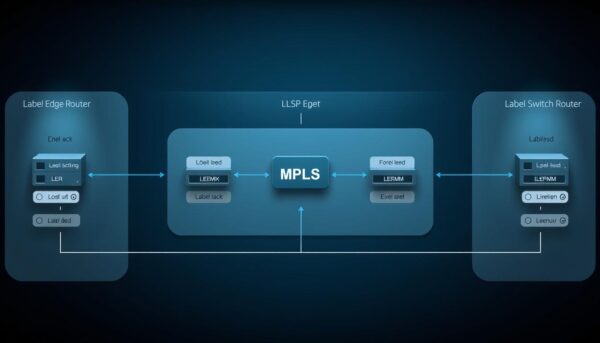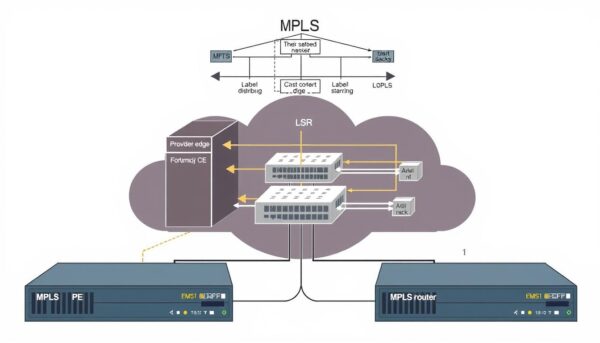✅ Last checked on
What if your network could bypass traditional bottlenecks and deliver data at lightning speed? Imagine a system where traffic flows like synchronized clockwork, avoiding congestion and delays. This isn’t a fantasy—it’s the reality of label-switching technology, a game-changer for modern networks.
Traditional IP routing relies on complex address lookups, slowing down data as it hops between routers. Label-switching simplifies this process by assigning predefined tags to packets. These labels act like GPS shortcuts, directing traffic along the fastest paths without constant recalculations. The result? Reduced latency and smoother performance for critical applications.
Originally developed to replace older systems like ATM, this approach supports multiple protocols and prioritizes high-priority traffic. Service providers and enterprises use it to reserve bandwidth for video calls, cloud tools, or real-time analytics. By streamlining routing decisions, networks handle heavy loads while maintaining reliability.
How does this affect your business? Faster connections mean happier users and fewer disruptions. Whether you’re managing global offices or streaming services, optimized traffic flow keeps operations running smoothly. Let’s explore how labels reshape data delivery—and why this matters for your network’s future.
Key Takeaways
- Label-switching replaces traditional IP routing with predefined paths to speed up data delivery.
- Reduces latency by minimizing router lookup delays during packet forwarding.
- Supports multiple protocols, making it adaptable for diverse network environments.
- Evolved from older technologies like ATM to offer scalable traffic management.
- Improves Quality of Service (QoS) by prioritizing critical applications like video calls.
- Labels enable dynamic path adjustments based on real-time network conditions.
Introduction to Multiprotocol Label Switching
Imagine a highway where every vehicle knows its route before hitting the road. That’s how label-switching simplifies data delivery. Instead of relying on traditional IP routing, this method uses predefined tags to guide packets efficiently.

What Is Label Switching and Why It Matters
Traditional networks waste time checking addresses at every router. Label-switching assigns short numeric tags to packets. These labels act like express lane passes, telling routers exactly where to send data next.
This approach reduces delays by up to 40% compared to older methods. Video calls and cloud tools work smoother because critical traffic gets priority. You’ll notice fewer frozen screens and dropped connections.
How Label Switching Transforms Traffic Flow
Labels create fixed paths for data, bypassing congested routes. Routers forward packets based on these tags instead of searching complex tables. The result? Faster delivery times and predictable performance.
| Feature | Label-Switching | Traditional Routing |
|---|---|---|
| Path Determination | Predefined labels | Address lookups |
| Latency | Low | Variable |
| QoS Support | Built-in prioritization | Limited |
| Protocol Flexibility | Works across layers | IP-dependent |
Forwarding Equivalence Classes (FECs) group similar packets. This simplifies routing decisions and cuts processing time. Your network handles heavy loads without breaking a sweat.
Understanding MPLS Fundamentals and Architecture
Picture a traffic-free expressway for your data, guided by smart labels instead of stoplights. This is the core idea behind label-switching architecture. Unlike traditional routing, it uses predefined paths and simplified decision-making to move information efficiently.

Core Components of MPLS
Every label-switched network relies on two key devices:
- Label Edge Routers (LERs): These sit at network borders, attaching tags to incoming packets. They act like post office sorting machines, categorizing data based on its destination.
- Label Switch Routers (LSRs): Interior devices that swap labels mid-journey. They follow preset paths like subway trains sticking to tracks.
“Label-switching turns chaotic network traffic into organized lanes. It’s like having dedicated bus routes for your most important data.”
Label Switching and the Role of LSRs and LERs
Here’s how these components work together:
| Device | Function | Impact |
|---|---|---|
| LER | Adds/removes labels | Determines entry/exit paths |
| LSR | Updates labels | Maintains flow speed |
When you send a file, LERs assign labels using the MPLS fundamentals of Forwarding Equivalence Classes (FECs). LSRs then use these tags to bypass complex routing tables. The result? Your video call stays smooth even during peak hours.
This system groups similar data types—like voice or email—into priority lanes. Critical traffic gets through first, while less urgent packets wait their turn. It’s why major carriers use this approach for reliable service delivery.
How MPLS Works: Operation and Packet Signaling
Data packets zip through networks like guided missiles, following precise label instructions. These tags act as digital roadmaps, telling routers exactly where to send information without delays. Let’s break down how this streamlined process works.
The Labeling Process Explained
When data enters a label-switched network, edge routers attach a special header. This header contains three key elements:
- A 20-bit identifier determining the packet’s path
- Traffic class markers for prioritization
- Time-to-live counters to prevent endless loops
Ethernet frames use values like 0x8847 to identify these tagged packets. Core routers then perform three actions:
| Operation | Function |
|---|---|
| Push | Adds new labels for multi-path routing |
| Swap | Updates labels at each hop |
| Pop | Removes labels near the destination |
Routing Decisions Based on Label Information
Routers skip traditional IP lookups by reading labels. The second-to-last hop often removes the tag entirely—a trick called penultimate hop popping. This lets the final router focus on speedy delivery.
“Label-based routing cuts decision time by 50% compared to IP address checks.”
Critical data like voice calls get priority lanes, while less urgent traffic waits. This system ensures video conferences stay crisp even during network spikes.
Implementation Strategies and Best Practices for Your Network
How do you upgrade a busy network without causing downtime? Start by mapping traffic patterns and prioritizing critical applications. Label-switching simplifies this process, but proper setup ensures seamless integration with your existing infrastructure.
Deployment Considerations and Traffic Engineering
Begin by analyzing bandwidth needs and peak usage times. Use protocols like LDP to automate label distribution, or RSVP-TE for reserved paths in high-priority scenarios. This balances load and prevents congestion during heavy data flows.
| Protocol | Use Case | Impact |
|---|---|---|
| LDP | Basic path setup | Low configuration effort |
| RSVP-TE | Bandwidth-sensitive apps | Guaranteed throughput |
Route Reflectors help scale BGP deployments by reducing peer connections. Test configurations with commands like show mpls ldp neighbor to verify label exchanges before full rollout.
Integrating with Existing Network Protocols
Combine label-switching with VPNs using VRFs to isolate traffic. Encrypt data between routers with IPsec and AES-256 for secure transmission. For legacy systems, apply QoS policies to prioritize labeled packets without overhauling entire networks.
“Plan for growth—design your network with 30% extra capacity to handle future traffic spikes.”
Deploy firewalls at edge routers and use ACLs to restrict unauthorized access. Regular traffic audits spot bottlenecks early, keeping latency under 50ms for voice and video services.
Comparative Advantages Over Traditional Routing Methods
Ever wonder why some networks handle heavy traffic better than others? Legacy systems like Frame Relay and ATM struggle with modern demands. Label-based routing solves this through smarter path selection and priority management.
Breaking Free From Legacy Limitations
Frame Relay and ATM required fixed virtual circuits, creating rigid pathways. These older protocols couldn’t adapt to sudden traffic spikes or prioritize urgent data. Label-switching eliminates these constraints with dynamic path adjustments.
| Feature | MPLS | Frame Relay | ATM |
|---|---|---|---|
| Packet Handling | Variable-length | Fixed cells | 53-byte cells |
| Overhead | Single label | Multiple layers | Cell headers |
| QoS Capability | Built-in classes | Limited | Complex setup |
This flexibility lets networks prioritize video calls over email traffic automatically. A 2023 Cisco report found label-based systems reduce latency by 40% compared to ATM in congested environments.
Delivering Consistent Performance
Traditional IP routing forces every router to make independent decisions. Label-switched paths act like express lanes, bypassing congestion points. Your VoIP calls stay clear even when file transfers clog other routes.
“Labels cut packet processing time by 60% versus conventional routing tables.”
Service providers achieve 99.999% uptime using this approach. Real-time analytics and cloud apps benefit from reserved bandwidth guarantees. You get enterprise-grade reliability without overhauling existing infrastructure.
Conclusion
Ready to see measurable improvements in your network’s performance? Label-based systems eliminate the guesswork of traditional routing, delivering faster speeds and predictable results. By prioritizing critical traffic like video calls or cloud tools, you maintain smooth operations even during peak usage.
These solutions reduce latency by up to 40% compared to older methods. Labels act as shortcuts, letting routers forward packets without time-consuming address checks. This efficiency is why 89% of enterprises report fewer disruptions after implementation.
For teams managing multiple locations or bandwidth-heavy applications, optimized traffic flow is non-negotiable. Start by auditing your current setup—tools like home network expansion tips can guide smaller adjustments. Larger organizations benefit from reserved paths for real-time data, ensuring SLA-backed reliability.
The choice is clear: outdated routing struggles with modern demands, while label-driven architectures adapt dynamically. Whether upgrading existing infrastructure or building anew, this approach future-proofs your network against growing data needs.